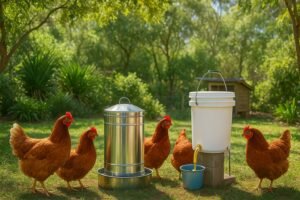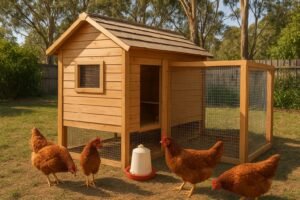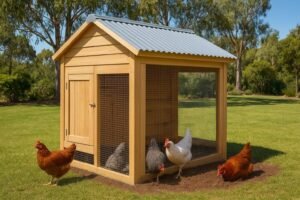If you live in Australia and keep backyard chickens, you know how serious the bushfire season can be. These fires are a major risk, not just for our homes, but for our animals too. Your chickens rely on you to keep them safe.
Having a clear plan before a fire starts is the best way to protect your flock. This guide will walk you through everything you need, from a bushfire survival kit for chickens to a simple 5-step evacuation plan, and what to do if you can’t leave. Let’s get your poultry prepared for an emergency.
Why Bushfire Preparedness Matters for Backyard Chickens
Chickens are more vulnerable than many pets. They can’t escape on their own, and their chicken coops are often made of wood, which can act like a tinderbox. It’s not just the flames; intense radiant heat, thick smoke, and extreme stress can harm or kill chickens long before a fire reaches them. This is why knowing how to keep chickens cool in summer in Australia is a key part of your overall summer preparedness, as heat stress and fire risk often go hand-in-hand.
On high fire danger days, things can change in minutes. That’s why “waiting to see” isn’t an option. A good fire plan for your pets, especially chickens, means you can act fast and without panic. This gives everyone, including your flock, the best chance of staying safe and is a key part of fire risk management for any animal owner.
Being prepared isn’t just about having a plan; it’s about having the right tools. Let’s look at what every chicken owner needs in their emergency kit.
What to Put in a Bushfire Survival Kit for Chickens
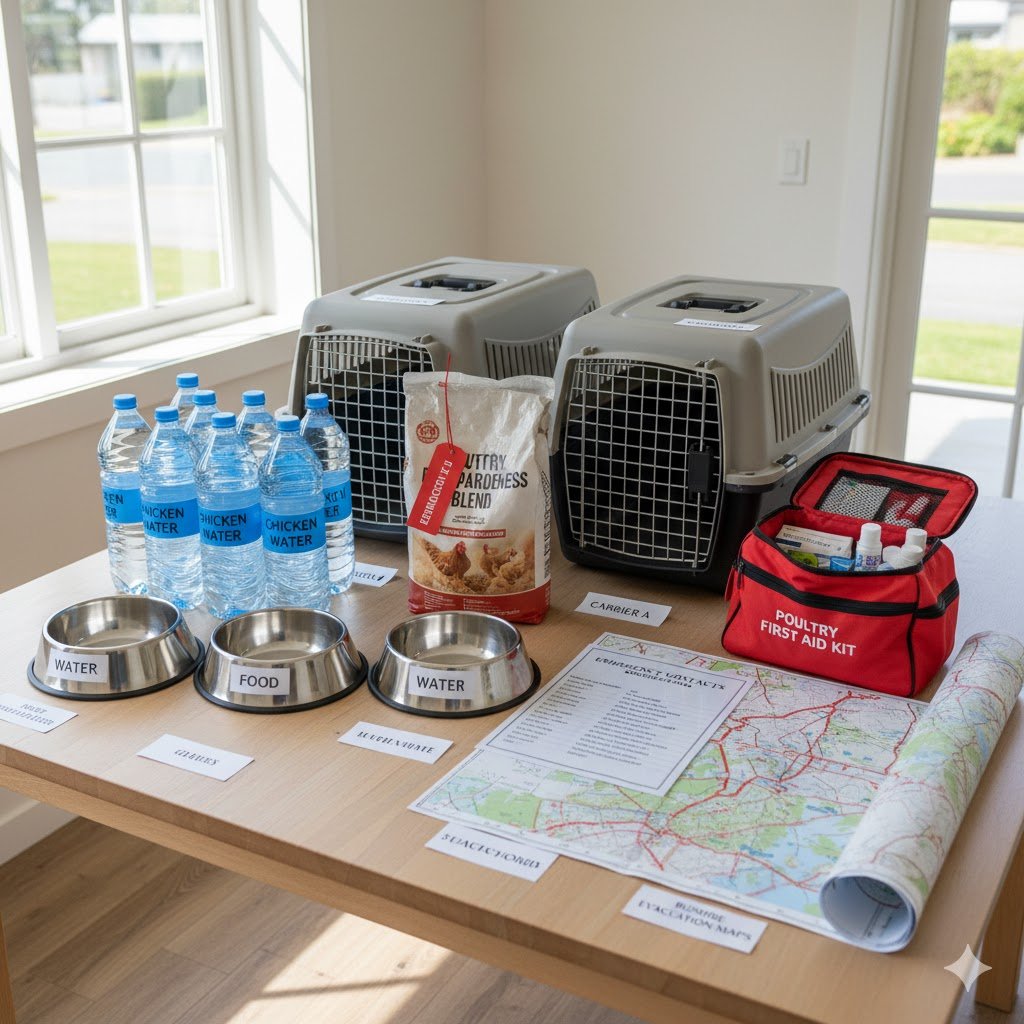
When you need to evacuate, you won’t have time to search for supplies. A pre-packed bushfire survival kit for chickens is a lifesaver. Keep it in a waterproof, clearly-labelled tub or bag in a spot you can grab quickly. Your kit should have everything your chickens need to survive for at least one week.
Essential Items for Your Chicken Emergency Kit
- Food and Water: At least one week’s supply of their regular chicken feed in a waterproof bag or container. Have several days’ worth of bottled water just for them.
- Bowls: Food and water bowls (travel, non-spill ones are great). Don’t plan on sharing with other animals, as this can spread disease.
- Carriers: Chicken carriers, pet crates, or even sturdy cardboard boxes with plenty of air holes. You’ll need one for every two or three chickens. Make sure to label each carrier with your name and phone number.
- Bedding: Old blankets, towels, or wood shavings to line the carriers. Towels are also useful for draping over the carriers to keep your chickens calm and help block smoke.
- Tools: A flashlight and spare batteries are essential, as you may be evacuating in the dark or in thick smoke.
- Temporary Shelter: A portable pop-up tent or small, fold-out enclosure in case your evacuation spot isn’t set up for chickens.
A Closer Look: Your Poultry First Aid Kit
A standard first-aid kit won’t have what you need for chickens. You can use our detailed guide on how to set up a chicken first aid kit at home as a base, but make sure to add these fire-specific items in a separate, waterproof bag:
- Saline Solution: For flushing smoke and ash from their eyes.
- Antiseptic: A poultry-safe antiseptic (like Betadine, diluted) for cleaning minor wounds.
- Burn Treatment: Liquid paraffin or a specific animal-safe burn gel to apply to minor burns on feet, combs, or wattles after cooling with water.
- Bandages: Sterile gauze pads and self-sticking “vet wrap,” which doesn’t stick to feathers.
- Electrolytes: A sachet of poultry electrolytes to add to their water. This is vital for helping them recover from stress and dehydration.
- Scissors & Tweezers: For cutting bandages or removing splinters.
Important Documents and Contacts
- Emergency Contacts: A printed list with your vet’s number (and an after-hours number), animal rescue groups, your local council, and your local fire service (like the CFA or RFS).
- Documents: Copies of any ownership or health documents.
- Photos: A recent photo of you with your chickens can help prove ownership if you get separated.
- Maps: Printed maps of your evacuation routes. Don’t rely on your phone’s GPS, as networks can go down.
With your kit packed and by the door, your next step is to know exactly what to do when you need to use it. That’s where your evacuation plan comes in.
5 Steps to Evacuate Your Chickens Safely During a Bushfire
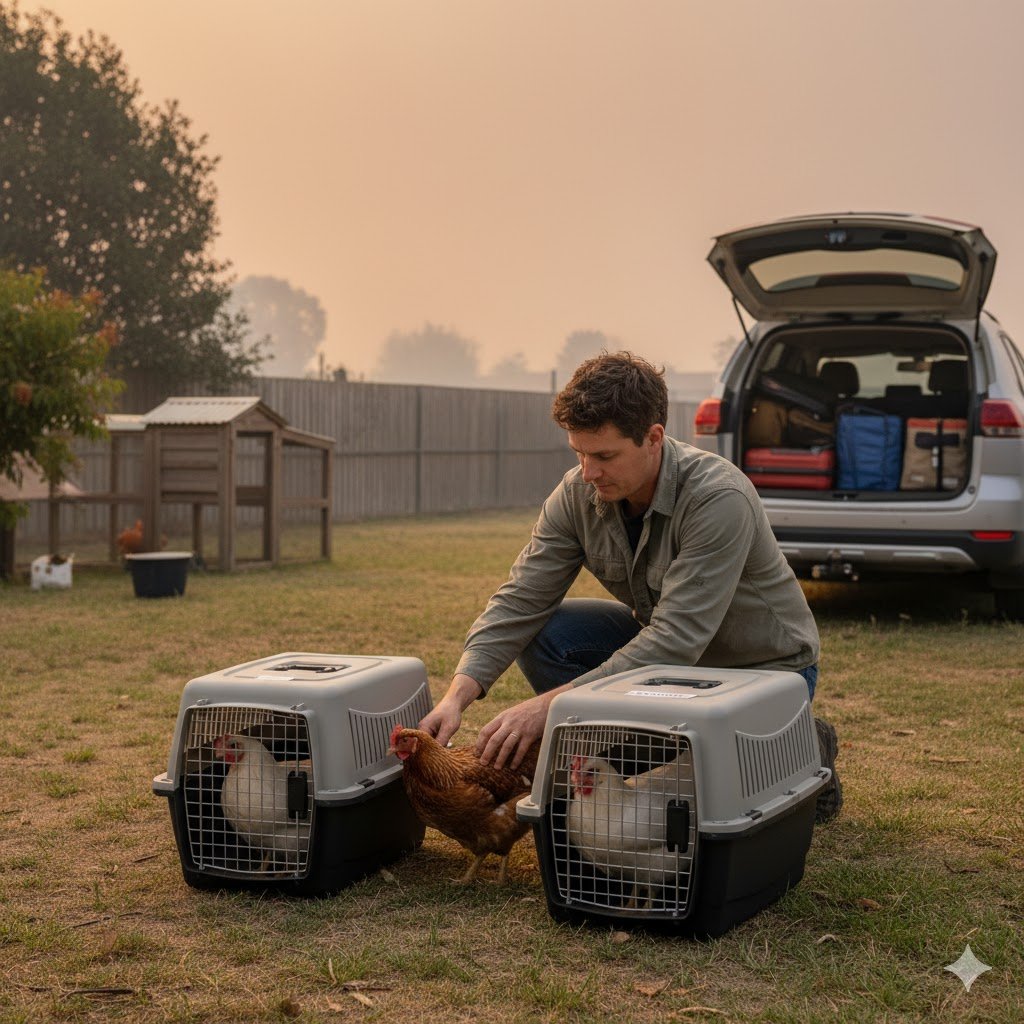
An evacuation is stressful, but a clear chicken evacuation plan makes it manageable. This 5-step plan breaks down what to do. The most important rule is to always leave early. If you wait until the fire is close, it’s too late. Your safety and your family’s safety must come first.
- Monitor Fire Danger Ratings: Stay glued to your local updates via the ABC radio and your state’s fire app (like ‘Fires Near Me’ in NSW). Know what the Fire Danger Rating means. On ‘Extreme’ and especially ‘Catastrophic’ days, your plan should be to leave long before a fire even starts.
- Prepare Your Emergency Kit: At the start of the bushfire season, check your kit. Replace old food, refresh water, and test the flashlight’s batteries. Do a practice drill: can you find the kit, catch one or two chickens, and have them in carriers in under 10 minutes?
- Plan and Practice Evacuation Routes: You need more than one way out. Plan at least two safe evacuation routes. Know where you will go—a friend’s house in a safer suburb, a relative’s place, or an official animal evacuation centre run by the council or Department of Primary Industries (DPI). Call ahead to your chosen spot to make sure they can take your chickens.
- Evacuate Early: This is the most critical step. Chickens are hard to catch when they’re scared. The easiest time to catch them is when they are roosting at dusk or first thing in the morning. On a high-risk day, don’t wait. Catch your chickens calmly and place them in their carriers with food, water, and bedding before you are told to evacuate. It’s much safer to move them while things are still calm.
- Temporary Shelter and Care: Once you reach your safe location, set up a quiet, safe, and well-ventilated (but not draughty) area for your chickens. Keep them in their carriers or your pop-up shelter. Give them fresh water with electrolytes first, then offer food. Keep them secure and don’t let them free-range in an unfamiliar, unfenced area.
A Quick Note on Biosecurity
If you go to a public or shared safe shelter for chickens, you need to think about biosecurity. This just means preventing sickness. While your setup is small, the principles from a poultry farm biosecurity plan are still vital: don’t share food or water bowls with other flocks. Keep your chickens in their own area if possible. This simple step can prevent your flock from picking up mites, lice, or diseases from other birds.
Evacuating early is always the best and safest option. But what if you are cut off and can’t leave? You need a “Plan B” for that, too.
What to Do If You Can’t Evacuate (Sheltering in Place)
Let’s be clear: this is a high-risk, last-resort option. It should only be used if you are cut off by the fire or have been officially told it is too late to leave.
This is a Last Resort
Your life is more important than your chickens. Only attempt these steps if you can do so safely after your own family and home are prepared.
How to Shelter Your Chickens
- Bring Them Inside (Safest Option): The best “shelter-in-place” plan is to bring your chickens inside your home. Put them in their carriers and place them in a laundry, bathroom, or garage (as long as the car is removed). Block the bottom of the door with wet towels to stop smoke from getting in. Stay with them.
- Move to a Safer Shelter: If you can’t bring them inside, move them to the most protected spot on your property. This might be a metal shed (not a wooden one) or on the “lee” side of your house (the side most protected from the wind and fire front).
- If They Must Stay in the Coop: This is the most dangerous option. Block all vents and openings with metal sheeting or thick, wet towels. Remove all flammable bedding (straw, woodchips) from the floor inside the coop, as embers can fly in and ignite it. Leave several large, wide, non-plastic bowls of water that can’t be tipped over.
Whether you evacuate or shelter in place, making your coop less of a fire risk is a job you can do well before the fire season.
How to Create a Fire-Resistant Chicken Coop
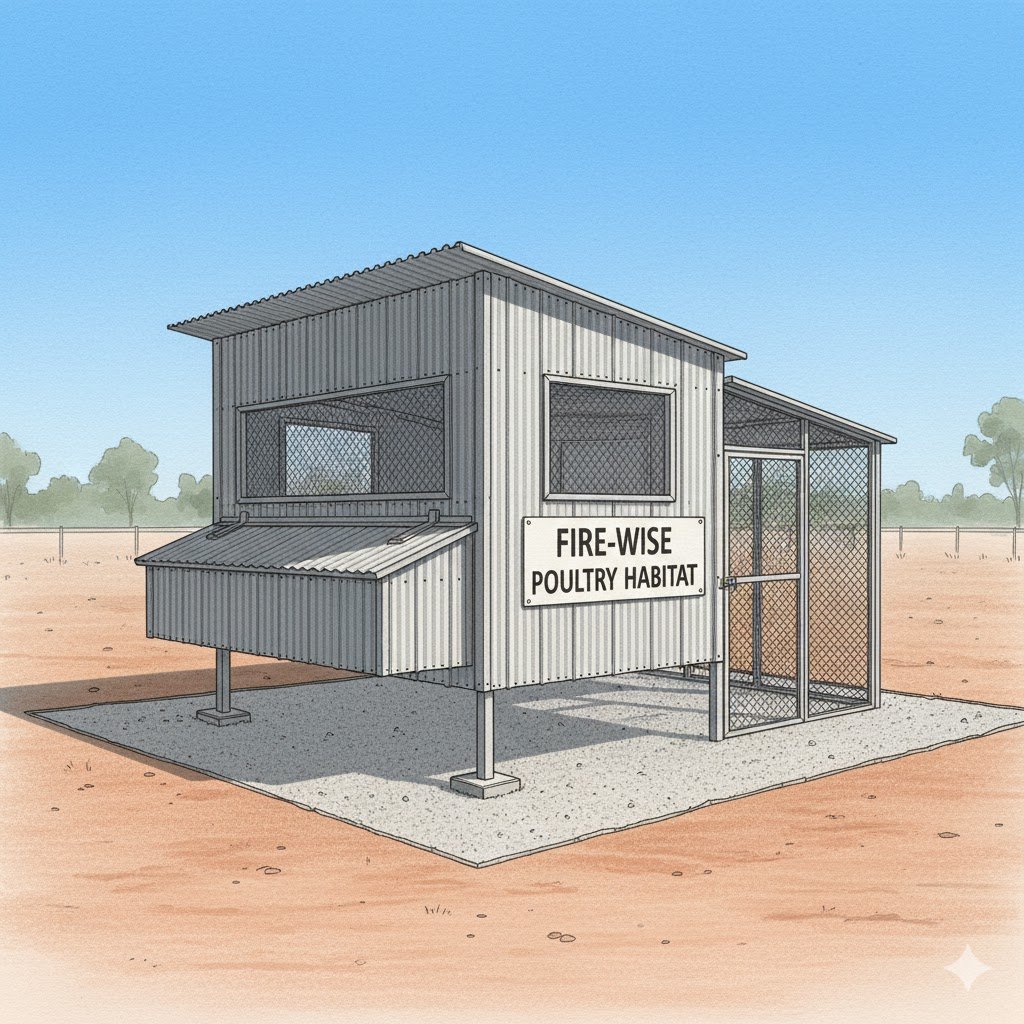
While you should always plan to evacuate, you can also make your chicken coop fire safety a priority. A more-resistant chicken coop and yard can help reduce your risk.
- Clear Defensible Space: This is the most important step. Keep a 10- to 20-metre “bubble” around your coop. This means no long, dry grass, no dry leaves, no woodpiles, and no flammable shrubs. Keep the grass mown short.
- Choose Materials Wisely: Build your coop from non-flammable materials like metal sheeting (Colorbond is excellent) instead of just timber. This is a key feature in many chicken coop designs for hot climates in Australia, which prioritize non-flammable materials and good ventilation. If your coop is wood, consider painting it with a fire-retardant paint.
- Landscaping and Yard Management: Don’t use flammable mulch like straw or woodchips anywhere near the coop. Use gravel, pebbles, or bare earth instead. Break up paths so fire can’t ‘climb’ from the fence to the coop.
- Secure the Coop: Cover all vents, windows, and openings with fine, metal mesh (like “ember guard” flyscreen wire), not plastic or fabric mesh. Embers can travel kilometres and will melt plastic instantly. This same mesh is also a key part of how to snake-proof your chicken coop in Australia, protecting your flock from multiple threats. Pairing this with one of the best automatic chicken coop doors in Australia can also ensure your flock is securely locked in before an emergency, making them easier to catch.
- Store Feed Safely: Keep bags of feed and bales of hay or straw in sealed metal bins or a separate, enclosed metal shed, far away from the coop and your house. Plastic bins will melt and the feed will ignite.
A safer coop gives you peace of mind, but it’s natural to still have questions. Let’s cover some of the most common ones.
After the Fire: Returning Home and Aftercare
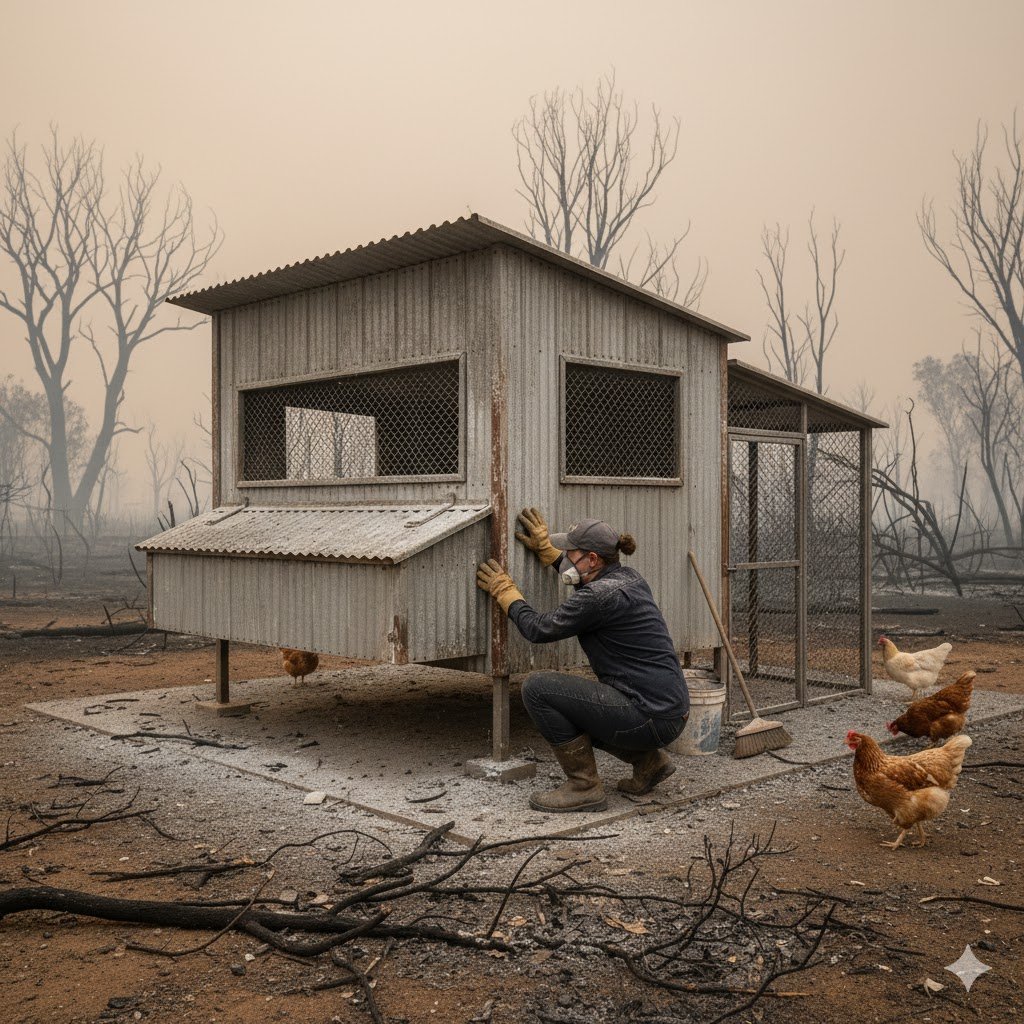
Once the authorities have given the all-clear, your focus will shift to returning home and checking on your flock’s health.
Checking Your Property and Coop
Your first job is to check for dangers.
- Look for Hazards: Be careful of fallen powerlines, smouldering spots, or damaged trees.
- Inspect the Coop: Check the coop for structural damage, sharp edges from melted metal or plastic, and broken glass. If the coop is badly damaged, you may need to look at new chicken coop plans for 20 chickens (or your flock size) for rebuilding.
- Clean Everything: Throw out all food and water, as it may be contaminated with ash or smoke. Scrub and disinfect all bowls, feeders, and waterers.
- Replace Bedding: Remove all old bedding and replace it with fresh, clean material.
- Secure the Area: Make sure there are no holes in the fence or coop where a dazed chicken could escape or a predator could get in. Fires often destroy fences, making your flock an easy target. Reviewing tactics for protecting your flock from Australian predators is crucial during this vulnerable time.
Health Checks and Aftercare for Your Flock
Stress and smoke can cause health problems that appear days later.
- Smoke Inhalation: This is a major risk. Listen for any coughing, gasping, or wheezing. If you hear this, call your vet. Keep the chicken in a calm, well-ventilated area.
- Burns: Gently check their feet, combs, and wattles. If you find minor burns, cool them with running water, gently apply the burn gel or liquid paraffin from your first aid kit, and call your vet for advice.
- Stress: This is the biggest hidden issue. Your chickens will be stressed. Add electrolytes to their water for the first few days. They may stop laying eggs for a while; this is normal. Keep their routine as calm and predictable as possible.
- Food and Water: Make sure they have constant access to fresh, clean water (with electrolytes) and their normal food.
This might seem like a lot to take in, but a little preparation goes a long way. Let’s quickly review the most important steps.
Frequently Asked Questions About Bushfire Safety for Backyard Chickens
What should I put in a bushfire survival kit for chickens?
Your kit needs at least a week’s supply of feed and water, food/water bowls, transport carriers, a specific poultry first aid kit (with electrolytes, burn gel, and saline), bedding, and a list of emergency contacts (vet, local fire service).
How do I evacuate chickens during a bushfire?
The best way is to evacuate early. Monitor fire danger ratings, have your emergency kit ready, and put your chickens in their carriers before the fire is a threat. Follow your planned evacuation route to a safe location.
What is the best way to transport chickens in an emergency?
Use pet carriers, crates, or sturdy cardboard boxes with air holes. Put familiar bedding inside. Draping a light towel over the carrier can keep them calm. Make sure they are secure so the chickens can’t escape.
How can I make my chicken coop fire-resistant?
Clear at least 10-20 metres of flammable material (like dry grass and leaves) from around your coop. Use metal materials for building if possible, and cover all vents with fine metal mesh to block embers. Store feed in metal bins away from the coop.
How do I check my chickens for injuries after a fire?
Gently check their feet, combs, and wattles for burns (which may look dark or blistered). Look for redness in their eyes. Listen for coughing, wheezing, or gasping, which are signs of smoke inhalation. If you see any of these, call your vet.
Who do I contact for help during a bushfire in Australia?
In an immediate, life-threatening emergency, call Triple Zero (000). For fire updates and warnings, check your state’s service (like the CFA in Victoria or RFS in NSW). For animal welfare help, you can contact RSPCA Australia or your state’s Department of Primary Industries (DPI).
Your Bushfire Safety Checklist (Conclusion)
- Before Summer: Build and label your chicken emergency kit. Clear 20 metres of defensible space around your coop. Plan and write down your evacuation routes and safe locations.
- During Fire Season: Check the Fire Danger Rating daily. Keep your car fuelled and your carriers somewhere easy to grab.
- On a High-Risk Day: Be ready to leave. Put your chickens in their carriers early in the day, before there is any smoke.
- If You Evacuate: Leave early. Take your kit. Call your safe location to let them know you are coming.
- If You Return: Check your property for hazards before letting your chickens out. Watch them closely for 2-3 days for any health issues and call your vet if you are worried.
Protecting your backyard chickens is all about planning, not panic. By following these steps and having a plan, you’re giving your flock the very best chance to stay safe this bushfire season.
Resources and Emergency Contacts for Australian Chicken Owners
You are not alone in this. Many organisations offer excellent advice on animal evacuation and emergency preparedness. Always listen to your local authorities first.
- Your State’s Fire Service: (e.g., CFA – Pets and Bushfires in Victoria, or the NSW Rural Fire Service (RFS), etc.). Download their official app on your phone for the most up-to-date warnings.
- RSPCA Australia: The RSPCA provides fantastic, state-specific checklists for creating a pet emergency plan. See RSPCA Victoria – Prepare with Your Pets for a great example.
- Department of Primary Industries (DPI): These government bodies are often the lead agency for livestock evacuation, (which includes poultry) in large-scale emergencies. See the NSW DPI – Emergency Preparedness guide for detailed planning. For general backyard chicken health and biosecurity, the NSW DPI – Backyard Chickens page is a practical resource.
- Your Local Vet: Have their number in your phone and on the paper list in your emergency kit. Find out their after-hours emergency number, too.
- Your Local Council: Check their website for information on local evacuation points, including any that are set up for animals.
- Australian Animal Welfare Standards: These guidelines help you understand your legal responsibilities. See the Agriculture Victoria – Australian Animal Welfare Standards and Guidelines for poultry.

Oladepo Babatunde is the founder of ChickenStarter.com. He is a backyard chicken keeper and educator who specializes in helping beginners raise healthy flocks, particularly in warm climates. His expertise comes from years of hands-on experience building coops, treating common chicken ailments, and solving flock management issues. His own happy hens are a testament to his methods, laying 25-30 eggs weekly.

